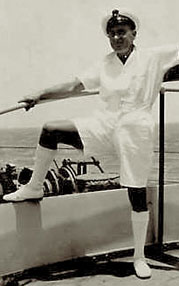CONTENTS
- Background: PQ17
- Biography: Jack Bowman
- HMS La Malouine
- Galleries:
- PQ17: Merchant Ships
- PQ17: Close Escort
PQ17 Diary
Jack Bowman

Engine Room Artificer (ERA) HMS La Malouine, 1940-44 (c) Bowman family archive.
Notes
June 1942
1. ASDIC was the name given to a hull mounted submarine detection system. Now commonly called Sonar. | back
2. Pom-pom guns were 2 pounder anti-aircraft weapons. The reference here is interesting because Lieutenant Caradus (La Malouine's Navigation officer) complains in his diary that the guns broke down during a particularly severe air raid on the convoy. The problem was obviously not resolved before leaving Londonderry. | back
3. Norman Birkett was a friend from Jacks home village of Windermere, coincidentally on the same convoy. | back
4. Ack-ack ships were generally merchantmen that had been heavily armed with anti-aircraft weaponry. Ack-ack was the nickname for anti-aircraft measures. Now commonly called triple A. | back
5. The Lakes is a common expression for the English Lake District, now in the county of Cumbria (then Cumberland & Westmorland), NW England. | back
6. Chief Petty Officers. | back
7. RDF is an abbreviation of Radio Direction Finder. The term was used before the Americans came up with the snappier description "Radar". | back
July 1942
1. They were in fact a Blohm und Voss spotter and two Heinkel He115 torpedo bombers. One of the bombers was later shot down whilst attacking the convoy. David Irving, in his book The Destruction of Convoy PQ17, conjectures that it was the rescue ship Zaafaraan which shot the 'plane down. That Jack Bowman assumed it was La Malouine is understandable. Zaafaraan and La Malouine were adjacent to one another in the convoy screen. Both would undoubtedly have been firing at the 'plane for all they were worth! After this bomber was downed the second He115, incredibly, landed on the sea to rescue the crew, whilst under heavy fire from the approaching escorts. They escaped safely! | back
2. Probably the Russian tanker Azerbaijan, which blew up, but did not sink. | back
3. William Hooper and Navarino were abandoned and later scuttled. | back
4. Lieutenant Bidwell, who was given the DSC for PQ17. | back
5. Orrest Head is a hill overlooking Windermere, Jack's home. | back
6. Following this signal Captain Lawford of Pozarica determined to use his small flotilla to engage the German Fleet. Pozarica signalled La Malouine:
"The enemy is expected to attack early tomorrow, 6 July. When we come within range of their heavy ships we shall turn towards them and fire as long as we can. Suggest that those off watch get sleep and make their Peace. But with God's help we shall survive." (Signal Log, La Malouine)
Jack's determination to sell his life dearly is not surprising given the suicidal nature of this order. | back
7. Pomorskaya Bay, Matochkin Strait. | back
8. The ships were Hoosier, Samuel Chase, El Capitan and Benjamin Harrison. La Malouine had in fact found these ships after being detailed by either Pozarica or Palomares to round up stray ships. The corvette referred to is HMS Lotus with survivors from Pankraft and River Afton. There were now 17 ships sheltering in the bay, of which only four were merchantmen. | back
9. HMS Dianella survived the convoy. | back
10. Benjamin Harrison ? | back
11. These were survivors of the John Witherspoon. The survivors thanked their rescuers by forcing the wardroom wine cupboard and getting thoroughly drunk. | back
12. David Irving says that it was La Malouine's First Lieutenant who led the boarding party, along with Hoosier's engineers and those from the late John Witherspoon. It can't be denied that Jack Bowman was with the boarding party as he "liberated" a steel thermos flask, still full of hot coffee, from Hoosier's engine room. He used the flask until his retirement 30 years later! La Malouine attempted to sink Hoosier by 4 inch gunfire. She failed however. Hoosier was eventually finished off by U-376. | back
13. Obviously a sentiment widely held amongst the ship's crew. Lt. Caradus made a remarkably similar comment in his diary | back
14. Byelushya Bay. David Irving says that the raft was unnamed. | back
15. Mistake? David Irving says that the ship was the Empire Tide, a British merchantman. The survivors which La Malouine took from this ship were from Paulus Potter and Hartlebury. | back
16. This was the small convoy led by the ASDIC trawler Ayrshire. Her captain, Lt. Gradwell, had hit upon the idea of painting the ships white, thus camouflaging them against the ice floes. Repainting the ships undoubtedly saved them from detection by hunting German bombers and U-Boats. The merchantmen accompanying Ayrshire were Troubadour, Ironclad and Silver Sword. | back
17. Pozarica. | back
September 1942